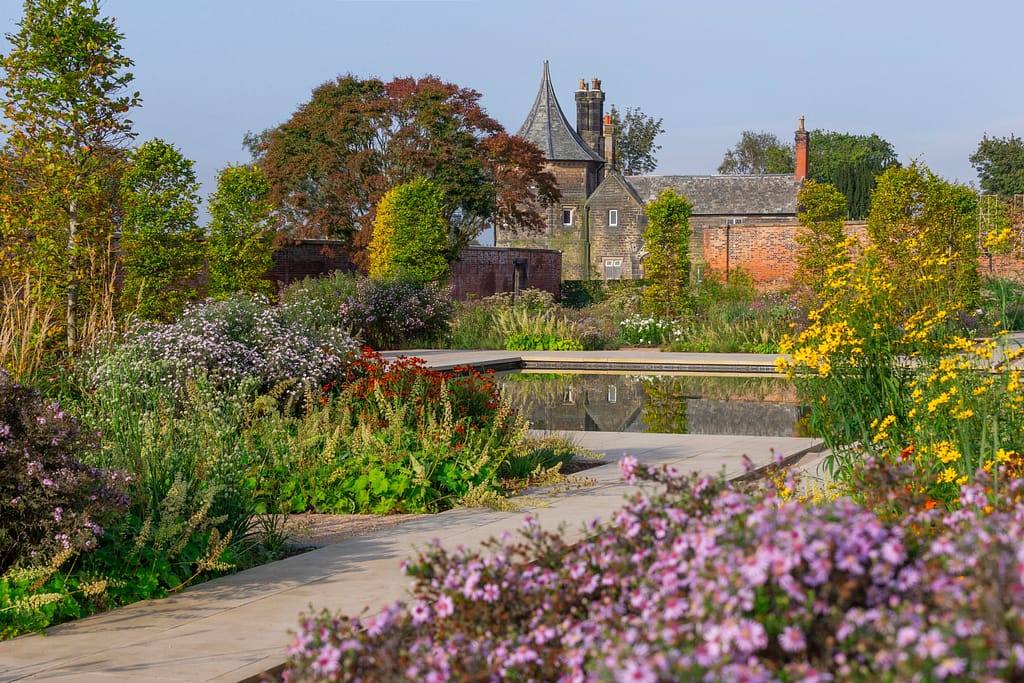What are Paradise Gardens?
The origin story of the Paradise Garden has its roots in Persia (roughly modern-day Iran and surrounding territories). The phrase “paradise” stems down from the Persian word meaning “walled garden”. It is also referred to as an Islamic garden and this type of garden was popular over a far-reaching spread throughout Persia, Egypt and the Mediterranean coast during the Muslim-Arabic conquests in the 7th century. Examples have also been found as far to the east as India and as far west as Spain.
So what makes a Paradise Garden? How can they be identified?
Harnessing Nature
There are certain key characteristics of the classic paradise garden which readily identify the style. On the whole, they are formal, symmetrical and more often than not enclosed. This enclosed environment keeps out unwanted plants and closes off the garden from outside eyes.
Paradise gardens have traditionally been rectangular, divided into four sections with a pond, pool or fountain as the focal point. This four-fold design is referred to as Chahar bagh or “four gardens”, and the central water feature is one of the most important elements of the garden. The four gardens represent the four rivers of paradise which are milk, honey, water and wine. Water with movement was especially favoured. The tinkling fall of a fountain or gentle rippling of a rill offer calmingly soporific sounds, as well as the practical purpose of cooling the air in the traditionally arid heat of the long Persian summer.
Date Palms, Figs and Olives were often grown in paradise gardens but the Arabic introduced oranges, lemons and pomegranates into them. Herbs and roses were also grown in the gardens for their scent and cooking, with plants being grown to create perfumes and lotions.
Whilst the traditional paradise garden conforms to the form and structure described, when it comes to your own garden, you can loosen the reins, take elements that appeal and draw on them crafting them into a contemporary take on your very own piece of paradise. There may not be any strict rules for creating your own version of a paradise garden, however, there is one basic requirement, which is that the garden should materialise the concept and tranquillity of a peaceful, otherworldly space.
We were approached for a garden design and installation flavoured with waters of a Persian inspired paradise. Let’s see how our team sculpted a mezze of middle-eastern designs into an Oxfordshire country garden. Read on to see the full project plan.

The Paradise project
With the different twists in mind for this design, we set to work on a plan. We firstly started by laying down a natural sandstone terrace area with colour-matched pointing on the slabs.

To connect the different sections and build tranquillity into its very heart, we built natural flagstone steps from the lower garden to the upper terrace; a walkway that will separate, yet connect each section and create a calming passage down through the garden. Keeping with tradition we created four sections of the garden and separated them with two low retaining Cotswold stone walls, capped with chosen natural sandstone to finish.
Looking back to the main elements of paradise gardens, our designer was keen to work in as much privacy as possible for the garden. Constructing a pressure treated softwood pergola closes off a section of the garden adding privacy through screening as well as a place to sit, relax and socialise.
One of the four sections was also crafted to conceal a potting shed. For this area, our team worked to prepare and construct a separate concrete base. Opposite, we placed oak sleeper raised beds, creating a kitchen garden filled with nutrient-rich growing soil. To complete the look, we laid the surface with a Cotswold self-binding floor.
We know that the most important factor of the paradise garden is the water feature. This took pride as the focal point in our garden design, just as it would in any classic paradise design. We designed a bespoke rill water feature in blockwork, with a G4 waterproof coating, to shimmer mirror-like right through the space; constant gentle movement brings soothing aqueous sound to this green Eden.

We also indulgently added a second watery creation. A bespoke urn style, self-contained water feature, which sits separately from the open surface rill feature, augmenting the softly elemental atmosphere.
As the hard landscaping reached conclusion, the soft landscaping team dispersed, tending to the planting scheme, putting the finishing touches to our idyllic design.
No matter what ideas you have for your garden, each of them is our own personal paradise in which we can disappear and escape reality. Talk to us about your thoughts about your garden, and we’ll help to shape them into existence.
Discover more about the history of Paradise Gardens…



